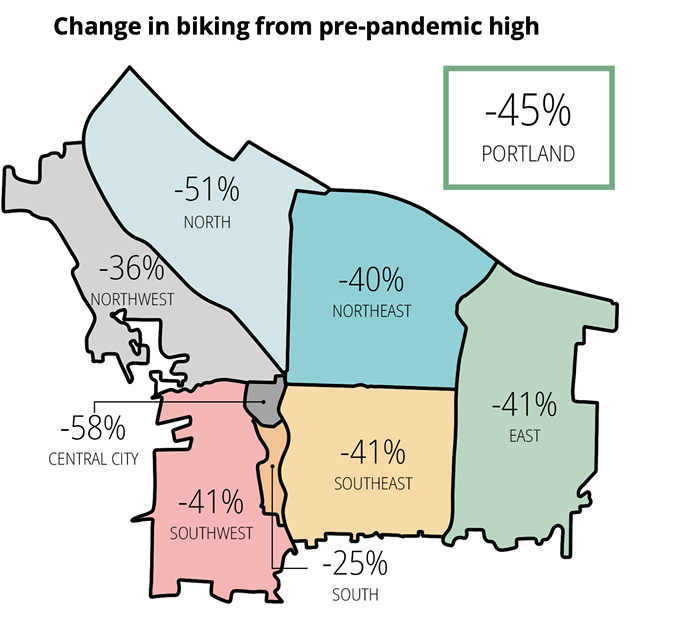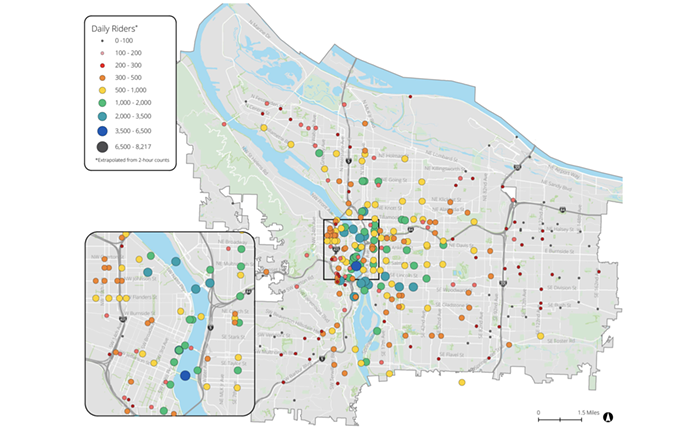The Portland Bureau of Transportation (PBOT) released the city’s 2023 bicycle count data this week, revealing an uptick in bike ridership compared to the year prior. But among local bike advocates, the verdict is still out about how to interpret the new numbers.
The initial findings from the 2023 report showed a nearly 5 percent increase in bike ridership numbers across Portland compared to last year. Counters tallied an average of 22,397 riders citywide— up from 21,278 in 2022, with even more prominent boosts in some parts of the city. Though some people have been quick to contextualize the new data in a historical context, minimizing the recent gains, reactions to the news have been mainly positive.
The contents of the 2022 bicycle count report, released last March, were significant enough to cause a citywide stir. According to the report, data from summer 2022 reflected a more than 40 percent drop in bicycle ridership since 2014, when Portland bike commuting was at its peak. The latest report shows the number of people biking in 2023 increased by nearly 5 percent compared to 2022— an upward trend, to be sure, but still a major decrease from a decade ago.
Nobody expected bike ridership to rebound back to 2014 levels in only a year. But the latest report reflects a continued uncertainty about how to get more people out of single-occupancy vehicles and onto bikes— especially since there’s no single reason for the cycling decline.
Traffic crash deaths in Portland are the highest they’ve been in more than 40 years, and as the effects of the climate crisis become impossible to avoid, there’s renewed urgency to curb transportation-related carbon emissions. Advocates recognize the importance of digging into the data, but they want city transportation leaders to remain clear-eyed about the importance of improving alternative transportation options in Portland regardless of what the annual count reflects.
History of the Portland bike count
PBOT leaders gather bicycle ridership data in several ways. Much of the report is based on a manual bike count, conducted between May and September by volunteers at more than 250 locations around the city. The counters tally how many people on bikes they see over a two-hour period during peak commute times, making note of the rider’s assumed gender and if they’re wearing a helmet. The totals are extrapolated to a weekday estimate.
This year, volunteers identified electric bikes in their counts for the first time (in the past, e-bikes have been counted in the tally, but not put in a distinct category). The count, which has historically included skateboards in a separate category, also included e-scooters and other small mobility devices for the first time this year.
PBOT also collected 24-hour automated bike counts using pneumatic tube vehicle counters at more than 60 locations, and that data is included in the annual ridership analysis. Finally, the report takes self-identified census data into account. The result is a comprehensive— but not perfect— set of numbers identifying the city’s point-in-time bike ridership.
Last March, PBOT released their first bicycle count report in nearly a decade.he results were startling to many local cycling advocates. According to the data collected by manual bike counters, ridership declined by about 45 percent citywide from 2014 (41,590 people tallied) to 2022 (21,278 riders counted).
Census data showed that, while 7.2 percent of Portland commuters reported bicycling to work in 2014, that number was down to 2.8 percent in 2021. This still means Portland boasts the highest share of bike commuters in the United States, but it’s a far cry from where the city once was.
Of course, something major occurred between 2013/2014 and 2021/2022 to change travel habits all over the world: The COVID-19 pandemic and the shift to remote work. The percentage of Portlanders who worked from home rose by nearly 30 percent between 2014 and 2021, impacting all other commute modes. But PBOT leaders said that wasn’t the whole story.
“From 2019 to 2022, cycling predictably dropped in every district due to the pandemic and dramatic changes in travel patterns,” last year’s bike count report stated. “Overall, the city saw a greater than one-third decrease in the number of people cycling across the city during the pandemic, but this decline was both a continuation and acceleration of a trend that began before 2016.”
Other ideas people had about why bike ridership declined so significantly included an increase in the perceived risks of cycling as traffic crash rates rose, a lack of safe, well-maintained bicycling infrastructure, unsanctioned campsites in bike lanes and paths, and more bike theft.
With all the fervor inspired by last year’s report, what are people making of the 2023 results?
Biking making a comeback?
PBOT’s 2023 bike count reflected a nearly 5 percent increase in riders citywide compared to 2022. But the results are more significant in some parts of the city: In Northwest, East, and South Portland, counters tallied increases of 14.9 percent, 12 percent, and 8.4 percent, respectively. Southeast, Northeast, North, and Southwest all saw an increase in ridership from the previous year, but the difference was by less than 5 percent.


The count also demonstrated other trends, most notably that nearly 17 percent of the Portland cyclists tallied— 4936 people— were riding electric bikes in 2023. East Portland and the Central City both saw the highest shares of people riding electric scooters— around 10 percent of total ridership.
At a Bicycling Advisory Committee (BAC) meeting on Tuesday, February 13, PBOT Transportation Planner Sean Doyle laid out some of the initial findings.
“[The upward trend] is a good sign, but we also have a long way to go,” Doyle said. “I think this gives us a better sense of how far we've come since peak cycle. And we know at some point in the past that we were able to achieve this level of people biking, and that was with even less infrastructure than we have today.”
Some BAC members questioned Doyle’s framing.
“I’m struck by the story I’m receiving from this presentation…what I’m feeling is mourning over the losses since 2016,” BAC member Jim Middaugh said. “I urge you all to consider the story you want to tell with this data. I am much more enthusiastic and buoyed and think it’s far more powerful to focus on the 5 percent recovery that we've seen since the pandemic.”
Middaugh said he thinks it’s important to ask “what we’re doing right to cause the recovery,” and “what we need to do more of to inspire people to get back on their bikes.”
“I’m getting doom and gloom here,” he said of Doyle’s presentation. “And I don’t think that’s the story you want to tell.”
Nic Cota, a board member on the advocacy group BikeLoud PDX, told the Mercury he thinks the latest results are “really good news.”
“It’s just nice to have a little gust of wind at the back of the sails once again,” Cota said. “It’s been almost a decade since Portland has seen some form of increase in ridership, so it's long overdue.”
But, Cota said, “there’s still a lot of work to be done.”
“We must keep asking how we expand the tent on who has access to ride their bike for transportation in Portland,” Cota said. “We also just came out of one of the deadliest years for road fatalities ever recorded [locally]. A lot still needs to be done to make our roads safer.”
The initial 2023 bike count data is available here. PBOT plans to release a more in-depth report about last year’s ridership numbers in March.




















